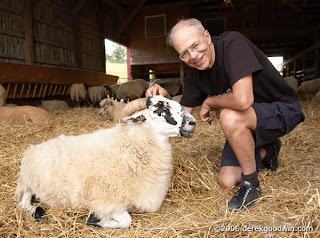Últimos assuntos
Tópicos mais visitados
Tópicos mais ativos

Peter Singer defende a bestialidade (sexo com animais) ?
Página 1 de 1
18042010

 Peter Singer defende a bestialidade (sexo com animais) ?
Peter Singer defende a bestialidade (sexo com animais) ?
Domingo, Abril 18, 2010
Heavy Petting
Peter Singer
Nerve, 2001
Not so long ago, any form of sexuality not leading to the conception of children was seen as, at best, wanton lust, or worse, a perversion. One by one, the taboos have fallen. The idea that it could be wrong to use contraception in order to separate sex from reproduction is now merely quaint. If some religions still teach that masturbation is "self-abuse," that just shows how out of touch they have become. Sodomy? That's all part of the joy of sex, recommended for couples seeking erotic variety. In many of the world's great cities, gays and lesbians can be open about their sexual preferences to an extent unimaginable a century ago. You can even do it in the U.S. Armed Forces, as long as you don't talk about it. Oral sex? Some objected to President Clinton' choice of place and partner, and others thought he should have been more honest about what he had done, but no one dared suggest that he was unfit to be President simply because he had taken part in a sexual activity that was, in many jurisdictions, a crime.
But not every taboo has crumbled. Heard anyone chatting at parties lately about how good it is having sex with their dog? Probably not. Sex with animals is still definitely taboo. If Midas Dekkers, author of Dearest Pet, has got it right, this is not because of its rarity. Dekkers, a Dutch biologist and popular naturalist, has assembled a substantial body of evidence to show that humans have often thought of "love for animals" in ways that go beyond a pat and a hug, or a proper concern for the welfare of members of other species. His book has a wide range of illustrations, going back to a Swedish rock drawing from the Bronze Age of a man fucking a large quadruped of indeterminate species. There is a Greek vase from 520 BC showing a male figure having sex with a stag; a seventeenth-century Indian miniature of a deer mounting a woman; an eighteenth-century European engraving of an ecstatic nun coupling with a donkey, while other nuns look on, smiling; a nineteenth-century Persian painting of a soldier, also with a donkey; and, from the same period, a Japanese drawing of a woman enveloped by a giant octopus who appears to be sucking her cunt, as well as caressing her body with its many limbs.

How much of this is fantasy, the King Kong-ish archetypes of an earlier age? In the 1940s, Kinsey asked twenty thousand Americans about their sexual behavior, and found that 8 percent of males and 3.5 percent of females stated that they had, at some time, had a sexual encounter with an animal. Among men living in rural areas, the figure shot up to 50 percent. Dekkers suggests that for young male farm hands, animals provided an outlet for sexual desires that could not be satisfied when girls were less willing to have sex before marriage. Based on twentieth-century court records in Austria where bestiality was regularly prosecuted, rural men are most likely to have vaginal intercourse with cows and calves, less frequently with mares, foals and goats and only rarely with sheep or pigs. They may also take advantage of the sucking reflex of calves to get them to do a blowjob.
Women having sex with bulls or rams, on the other hand, seems to be more a matter of myth than reality. For three-quarters of the women who told Kinsey that they had had sexual contact with an animal, the animal involved was a dog, and actual sexual intercourse was rare. More commonly the woman limited themselves to touching and masturbating the animal, or having their genitals licked by it.
Much depends, of course, on how the notion of a sexual relationship is defined. Zoologist Desmond Morris has carried out research confirming the commonplace observation that girls are far more likely to be attracted to horses than boys, and he has suggested that "sitting with legs astride a rhythmically moving horse undoubtedly has a sexual undertone." Dekkers agrees, adding that "the horse is the ideal consolation for the great injustice done to girls by nature, of awakening sexually years before the boys in their class, who are still playing with their train sets . . . "
The existence of sexual contact between humans and animals, and the potency of the taboo against it, displays the ambivalence of our relationship with animals. On the one hand, especially in the Judeo-Christian tradition — less so in the East — we have always seen ourselves as distinct from animals, and imagined that a wide, unbridgeable gulf separates us from them. Humans alone are made in the image of God. Only human beings have an immortal soul. In Genesis, God gives humans dominion over the animals. In the Renaissance idea of the Great Chain of Being, humans are halfway between the beasts and the angels. We are spiritual beings as well as physical beings. For Kant, humans have an inherent dignity that makes them ends in themselves, whereas animals are mere means to our ends. Today the language of human rights — rights that we attribute to all human beings but deny to all nonhuman animals — maintains this separation.
...
Read more here/Leia mais aqui.
+++++
NOTA DESTE BLOGGER:
Alguém viu alguma linha na Grande Mídia tupiniquim sobre a defesa da bestialidade (sexo com animais) feita por Peter Singer, professor da Princeton University? Eu não vi.
Heavy Petting
Peter Singer
Nerve, 2001
Not so long ago, any form of sexuality not leading to the conception of children was seen as, at best, wanton lust, or worse, a perversion. One by one, the taboos have fallen. The idea that it could be wrong to use contraception in order to separate sex from reproduction is now merely quaint. If some religions still teach that masturbation is "self-abuse," that just shows how out of touch they have become. Sodomy? That's all part of the joy of sex, recommended for couples seeking erotic variety. In many of the world's great cities, gays and lesbians can be open about their sexual preferences to an extent unimaginable a century ago. You can even do it in the U.S. Armed Forces, as long as you don't talk about it. Oral sex? Some objected to President Clinton' choice of place and partner, and others thought he should have been more honest about what he had done, but no one dared suggest that he was unfit to be President simply because he had taken part in a sexual activity that was, in many jurisdictions, a crime.
But not every taboo has crumbled. Heard anyone chatting at parties lately about how good it is having sex with their dog? Probably not. Sex with animals is still definitely taboo. If Midas Dekkers, author of Dearest Pet, has got it right, this is not because of its rarity. Dekkers, a Dutch biologist and popular naturalist, has assembled a substantial body of evidence to show that humans have often thought of "love for animals" in ways that go beyond a pat and a hug, or a proper concern for the welfare of members of other species. His book has a wide range of illustrations, going back to a Swedish rock drawing from the Bronze Age of a man fucking a large quadruped of indeterminate species. There is a Greek vase from 520 BC showing a male figure having sex with a stag; a seventeenth-century Indian miniature of a deer mounting a woman; an eighteenth-century European engraving of an ecstatic nun coupling with a donkey, while other nuns look on, smiling; a nineteenth-century Persian painting of a soldier, also with a donkey; and, from the same period, a Japanese drawing of a woman enveloped by a giant octopus who appears to be sucking her cunt, as well as caressing her body with its many limbs.

How much of this is fantasy, the King Kong-ish archetypes of an earlier age? In the 1940s, Kinsey asked twenty thousand Americans about their sexual behavior, and found that 8 percent of males and 3.5 percent of females stated that they had, at some time, had a sexual encounter with an animal. Among men living in rural areas, the figure shot up to 50 percent. Dekkers suggests that for young male farm hands, animals provided an outlet for sexual desires that could not be satisfied when girls were less willing to have sex before marriage. Based on twentieth-century court records in Austria where bestiality was regularly prosecuted, rural men are most likely to have vaginal intercourse with cows and calves, less frequently with mares, foals and goats and only rarely with sheep or pigs. They may also take advantage of the sucking reflex of calves to get them to do a blowjob.
Women having sex with bulls or rams, on the other hand, seems to be more a matter of myth than reality. For three-quarters of the women who told Kinsey that they had had sexual contact with an animal, the animal involved was a dog, and actual sexual intercourse was rare. More commonly the woman limited themselves to touching and masturbating the animal, or having their genitals licked by it.
Much depends, of course, on how the notion of a sexual relationship is defined. Zoologist Desmond Morris has carried out research confirming the commonplace observation that girls are far more likely to be attracted to horses than boys, and he has suggested that "sitting with legs astride a rhythmically moving horse undoubtedly has a sexual undertone." Dekkers agrees, adding that "the horse is the ideal consolation for the great injustice done to girls by nature, of awakening sexually years before the boys in their class, who are still playing with their train sets . . . "
The existence of sexual contact between humans and animals, and the potency of the taboo against it, displays the ambivalence of our relationship with animals. On the one hand, especially in the Judeo-Christian tradition — less so in the East — we have always seen ourselves as distinct from animals, and imagined that a wide, unbridgeable gulf separates us from them. Humans alone are made in the image of God. Only human beings have an immortal soul. In Genesis, God gives humans dominion over the animals. In the Renaissance idea of the Great Chain of Being, humans are halfway between the beasts and the angels. We are spiritual beings as well as physical beings. For Kant, humans have an inherent dignity that makes them ends in themselves, whereas animals are mere means to our ends. Today the language of human rights — rights that we attribute to all human beings but deny to all nonhuman animals — maintains this separation.
...
Read more here/Leia mais aqui.
+++++
NOTA DESTE BLOGGER:
Alguém viu alguma linha na Grande Mídia tupiniquim sobre a defesa da bestialidade (sexo com animais) feita por Peter Singer, professor da Princeton University? Eu não vi.

Carlstadt- Administrador

- Mensagens : 1031
Idade : 48
Inscrição : 19/04/2008
 Tópicos semelhantes
Tópicos semelhantes» Presidente Autraliano defende sua fé.
» Ateu defende vegetarianismo
» Fósseis de animais gigantes
» Paulo defende o Dízimo em I Coríntios 9
» Animais gigantes encontrados recentemente
» Ateu defende vegetarianismo
» Fósseis de animais gigantes
» Paulo defende o Dízimo em I Coríntios 9
» Animais gigantes encontrados recentemente
Permissões neste sub-fórum
Não podes responder a tópicos
 Início
Início








 Seja fã Forumeiros
Seja fã Forumeiros
» Acordem adventistas...
» O que Vestir Para Ir à Igreja?
» Ir para o céu?
» Chat do Forum
» TV Novo Tempo...
» Lutas de MMA são usadas como estratégia por Igreja Evangélica para atrair mais fiéis
» Lew Wallace, autor do célebre livro «Ben-Hur», converteu-se quando o escrevia
» Ex-pastor evangélico é batizado no Pará
» Citações de Ellen White sobre a Vida em Outros Planetas Não Caídos em Pecado
» Viagem ao Sobrenatural - Roger Morneau
» As aparições de Jesus após sua morte não poderiam ter sido alucinações?